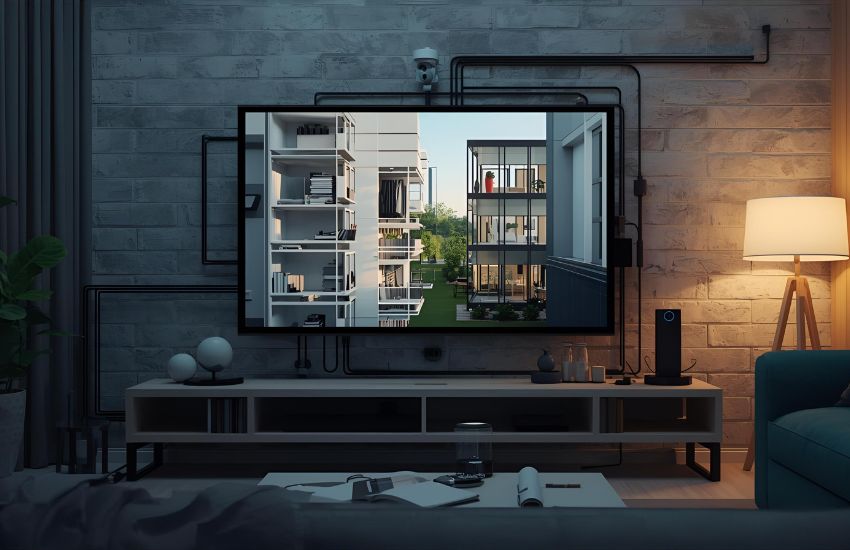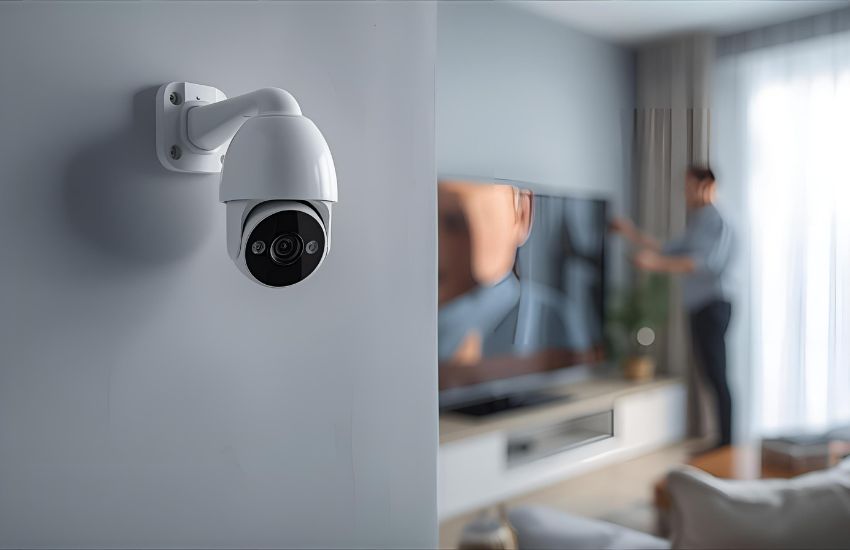Connecting a CCTV camera to your TV may seem complex, but it’s one of the most effective ways to enhance your home or business surveillance system with real-time visibility. Whether you’re securing a residence or monitoring a commercial property, the ability to view your camera feed directly on a TV offers both convenience and control.
To connect a CCTV camera to a TV for reliable surveillance, use the appropriate converter (0/1-4) and plug the camera’s video output into the TV’s input port. Ensure proper installation with compatible cables and devices. This setup allows real-time monitoring on a smart TV, making it easy to view surveillance footage without extra equipment.
In this blog, you’ll learn exactly how to connect a CCTV camera to your TV, what hardware like HDMI and cables you’ll need, and how to choose the right setup for HD output. From wired to wireless options, we’ll explore everything you need for a seamless and modern security camera viewing experience.
Understanding Your Options: How to Connect CCTV Camera to TV for Live Viewing and Enhanced Surveillance

Wired Connections: Using DVRs and Cables for Reliable Viewing
When connecting a CCTV camera to a TV, one of the most common and dependable methods is through a DVR (Digital Video Recorder). This device acts as a central hub that manages video input from multiple cameras, processes the footage, and sends an HD output to your monitor or TV. To establish this connection, you will typically use coaxial or BNC cables, which transmit the video signal reliably over longer distances. With a DVR-based system, you can enjoy real-time viewing on your TV, along with options for recording and playback.
Using cables in a wired setup guarantees a stable connection with minimal interference, making it ideal for users prioritizing consistent HD quality and dependable surveillance.
Wireless and IP Camera Options: Flexibility and Modern Convenience
If you prefer a less cluttered setup, consider an IP camera system that transmits video data over your local network. Instead of relying on traditional cables, IP cameras send a digital video stream to an NVR (Network Video Recorder) or directly to your monitor or TV via compatible devices. This option supports higher resolution and easier scalability when adding more cameras.
Wireless systems provide flexibility in installation locations and reduce the need for complex wiring. However, they require robust network support to ensure smooth viewing without lag or signal loss.
Choosing the Right Monitor and Ensuring Compatibility
Whether you use a wired DVR or a wireless NVR system, selecting a compatible monitor or TV that supports the necessary input and output options is crucial. Many modern TVs offer HD input ports, including HDMI, which can carry high-definition video signals from your surveillance system with ease. Ensuring your equipment supports the right resolution and connection standards will maximize your live viewing experience and overall system performance.
See more about…Video Surveillance from Android & iPhone Mobile App
Step-by-Step Guide to Connecting CCTV Camera Using HDMI Cable, DVR, or Wireless Setup

Connecting CCTV Camera to TV Using an HDMI Cable
To connect a CCTV camera to TV using an HDMI cable, you first need to ensure your camera system supports HDMI output, typically through a DVR or NVR device. Begin by connecting the HDMI cable from the DVR to the HDMI port on your TV. This setup allows you to view high-definition footage directly on your TV screen. Once connected, switch your TV input to the corresponding HDMI channel. This method is straightforward and provides excellent video quality, ideal for real-time monitoring.
Using a DVR to Connect a Security Camera to TV
If you are connecting CCTV cameras via a DVR, start by linking your security camera to the DVR using coaxial or compatible cables. Then, connect the DVR to your TV using an HDMI cable or other supported connections. The DVR processes and manages video feeds, enabling you to view multiple cameras on one screen, record footage, and play back recordings as needed. This is a popular method for reliable, centralized surveillance.
Wireless Setup: Connecting a CCTV Camera to TV Without Extensive Wiring
For greater flexibility, you can connect a CCTV camera to TV wirelessly. This option often involves an IP-based HD security camera that streams video over your local network to an NVR or directly to a compatible TV or monitor with wireless support. You may need to install specific apps or software to facilitate the connection and viewing process. Wireless setups reduce cable clutter while still providing high-quality surveillance footage on your TV.
Choosing the Right TV for Live View: Optimizing Your Security Camera to TV Connection for HD Monitoring
Selecting the right TV for live view is essential to optimize your camera to TV for live surveillance experience. When choosing a TV, you should prioritize models with multiple HDMI input ports, as these allow you to connect various devices simultaneously, including your DVR or NVR systems. Although older TVs may rely on RCA connections, modern setups benefit greatly from HDMI’s superior signal quality and ease of use.
If your setup includes multiple cameras on TV, ensure your system supports switching or displaying several feeds seamlessly, providing comprehensive coverage on a single screen. Some users prefer to connect camera directly to the TV; however, this typically limits functionality unless the TV supports IP camera streaming or specialized apps.
For enhanced flexibility, consider wireless solutions that allow you to use a security camera without extensive cabling, simplifying installation and enabling remote placement. Keep in mind, however, that wireless setups may require stable network conditions to maintain smooth video transmission.
Ultimately, choosing a TV that balances input options, resolution, and compatibility with your surveillance system ensures that your TV for live view delivers clear, reliable monitoring tailored to your security needs.
See more about...Security Camera System Android
Conclusion
In conclusion, successfully connecting your surveillance system to TVs for live monitoring requires careful consideration of your setup and compatible devices. Whether you use a converter to adapt different video signals or rely on a direct video input via HDMI or coaxial cables like RG59, proper installation is crucial to minimize signal loss and ensure a clear video output. If you want to connect multiple cameras—such as 4 cameras through a DVR or a PoE switch—choosing the right device and accessories will help you transmit video smoothly without interruption. Additionally, using a reliable router and compatible camera applications can enhance your ability to view live camera feeds remotely on smart TVs or other monitors. Prioritizing compatible equipment and thoughtful setup guarantees an efficient surveillance system that meets your security needs with high-quality, uninterrupted video signals.
See more about...CCTV Camera with Motorized Zoom Lens
Frequently Asked Questions (How to Connect CCTV Camera to TV for Reliable and Modern Surveillance Solutions)
How to connect a CCTV camera directly to a TV?
To connect a CCTV camera directly to a TV, plug the camera’s video output cable (usually a BNC connector) into a BNC-to-RCA adapter, then connect it to the TV’s video input port. Power the camera using its adapter, switch the TV to the correct AV input source, and the live feed will display instantly.
Can I use a TV as a CCTV monitor?
Yes, you can use a TV as a CCTV monitor if the TV has compatible input ports, such as HDMI, VGA, or RCA. Most modern DVRs and NVRs connect easily to TVs using HDMI cables, while older systems may use RCA. Simply connect the CCTV output to the TV input, select the correct source, and view footage directly.
How can I view my CCTV on my smart TV?
You can view your CCTV on a smart TV by connecting the DVR/NVR to the TV using an HDMI or VGA cable. If your system supports IP cameras, install the CCTV app from the TV’s app store or use screen mirroring from your smartphone. Ensure both devices are on the same network for smooth live streaming.
How do we analyse CCTV footage using modern technology?
CCTV footage can be analyzed using modern technology such as AI-powered video analytics, motion detection, and facial recognition. These tools help identify suspicious activities, track movements, and detect unusual behavior in real time. Advanced software can also enhance image quality, generate automated alerts, and integrate with databases for efficient monitoring, investigation, and security management.
